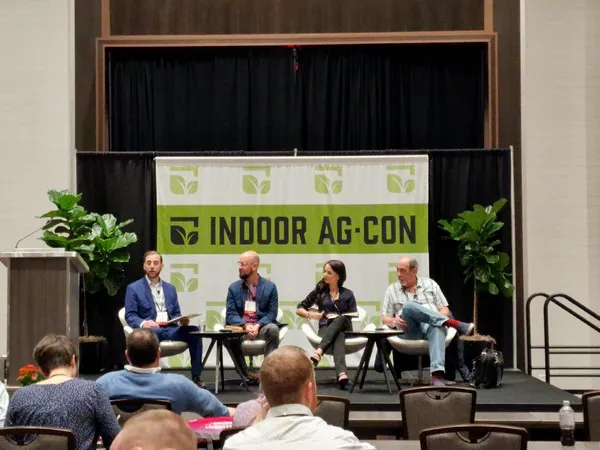With day two of Indoor Ag-Con in the books, we take time to look back at one of the keynote sessions from the first day, “Failing Forward – Lessons Learned.” As part of the Trends & Innovations Track, this session focused on why some vertical farms have failed and what today’s vertical farms can do to avoid the same fate. This keynote session was moderated by Kyle Barnett of Indoor Ag-Con, with panelists Glenn Behrman, Erika Summers, and Chris Cerveny.
Three main takeaways to keep your farm afloat
The panelists focused on three main lessons that are essential to vertical farms’ continued operation. These lessons are pre-launch preparations, optimizing operations, and ensuring product flow after harvest.
1) Pre-launch considerations: keep it realistic
Chris Serveny, co-founder and president of Bridge City Global LLC, explains that vertical farms need to be realistic in where they choose to build. While reclaiming unused urban areas is a hot topic right, vertical farming companies should not underestimate the challenges that come with the terrain, such as city taxes, utilities, and acquisition or leasing.
“You have to be cost-effective first, especially if your main goal is to provide a low-cost product. You need to focus on a goal and align everything else to it,” says Chris.
Adding to this point, CEA advisor Erika Summers explains that when repurposing unused buildings, vertical farms need to understand that their operations will be very different than typical commercial or industrial uses and that these operations may require building reinforcements, power upgrades, high-capacity HVAC systems, power back-ups, municipal licensing, etc.
“When looking at commercial real estate, a good building may not be a good building for vertical farming,” Erika says.
Beyond the building, CEA advisor Glenn Behrman also notes that prospective vertical farms need to do a thorough market analysis, determine the market potential of the crop, find the budget, and don’t rely on salespeople to tell you what is best for your situation.
2) Operations: automation is great, but don’t rely solely on it
Whether implementing automation solutions or not, all panelists concur that it is extremely important for growers to get up close and personal with the farm - you need to understand what is happening on your farm.
“You have to be intimate with every aspect of your operation, whether your farm is 28 hectares or 1.000 square feet. You cannot sit back; you need to get out and get your hands dirty,” says Glenn.
“Automation is good, but I think you need boots on the ground to validate the technology. Get better before getting bigger,” Chris notes.
As Erika notes, there are numerous automation solutions on the market, but she hasn’t seen anyone get it right yet, with many farms still having people mill around and incurring substantial labor costs. She explains that there are some low-hanging fruits that can help farms improve operational efficiencies, such as automated seeders and harvesting machines.
3) Post-harvest efficiency
Crop harvest is like the finish line, but things can still go wrong at this point. For one thing, harvesting consistency can be hampered by inconsistent harvesting methods resulting in leafy greens being harvested too high, for example, and reducing the total weight harvested. Also, improper harvesting and handling techniques can lead to browning, wilting, or the proliferation of dangerous pathogens. To this effect, Erika notes that it is really important that vertical farms communicate their message well, highlighting that workers need to care about the products to prevent food safety issues that only taint the public’s view of the farm but of the vertical farming industry as a whole.
“Workers need to understand the sanitation process, why it’s important, what damage pathogens cause, and how to be proactive to potential challenges,” says Erika.
Outside of the farm, there is always the question of offtake and how the product will find the end consumer. The produce industry is very relationship-driven, and as vertical farming is new to the game, it must contest well-established relationships between marketers, retailers, and greenhouse or field growers.
“If a retailer has been working with growers that have 10 acres worth of product and have been working with them for 10 years, they may be less inclined to work with a VC-funded vertical farm,” Glenn explains.
So, how can vertical farms avoid failure?
The panelists concluded the session with overarching tips for remaining successful in the vertical farming industry, all of which centered around collaboration. Chris notes that it is important to surround yourself with teachable, curious people who will recognize their mistakes and learn from them. In a similar vein, Erika stressed the importance of diving deep into the farm mechanics with CEA experts, power companies, engineers, etc., before getting a new building so that the farm does not begin at a disadvantage.
For more information:
Indoor Ag-Con 
www.indoor.ag
